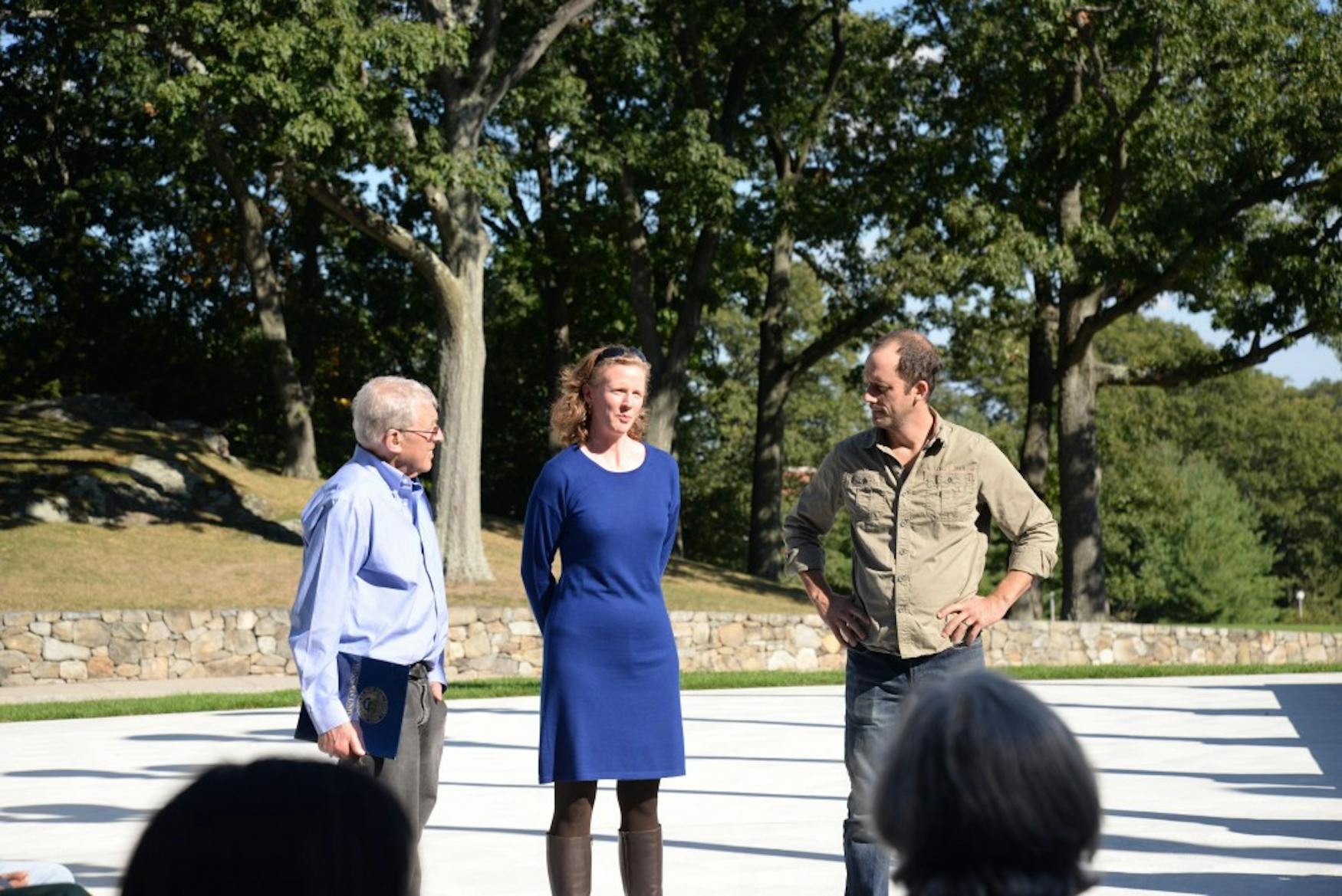Scholars lead discussion on “Light of Reason”
If you can identify the message or moral of the Rose Art Museum’s newest sculpture, Prof. Chris Abrams (FA) asks that you not tell him.
On Wednesday, Abrams and Prof. Gordon Fellman (SOC) led a discussion about the newly installed sculpture, “Light of Reason,” in front of the museum. The sculpture, created by artist Chris Burden, consists of repurposed lampposts set into concrete blocks. The blocks are set in three rows, with the outer two rows pointing diagonally to the middle row, and the middle row drawing a path straight into the museum. The lights turn on at about six pm, or earlier if it gets dark, and the sculpture’s light makes the otherwise cool, grey cement blocks look welcoming.
Abrams started the discussion by noting that as Burden’s career progressed, his installations grew in scope and size. So-called “historical” Burden art was extreme performance art, including a performance titled “Shoot” where Burden had an assistant shoot him in the arm with a .22 caliber rifle.
In another piece, “Trans-Fixed” (1974), Burden nailed his hands into a Volkswagen Bug and lay face up in a pose reminiscent of crucifixion. The Bug was parked on a street in California for two minutes before it was returned to the garage and Burden’s assistants helped him down. Evidently, Burden was not one to shy away from danger.
Following this theme, in a 1975 installation called “Doomed,” Burden resolved to lie under a leaned sheet of glass at the Museum of Contemporary Art in Chicago until the public interfered with the glass or the clock beside it. A museum employee eventually brought Burden some water, after which time Burden moved from under the glass and used a hammer to break the clock, ending the installation.
Burden gradually moved from more shocking and moralistic pieces to larger and more open installations. By the 1990s, Burden was creating pieces like “Metropolis 2,” which modeled a traffic jam in Los Angeles, and “Mexican Bridge,” a piece from Burden’s installation series of steel bridges. The Rose hosted both of these works in the past, so it is fitting that Burden’s most expansive piece, “The Light of Reason,” would also make its way to campus.
One attendee mentioned that the structure’s columns reminded her of a Greco-Roman forum, and that the professors standing amidst the lampposts were reminiscent of philosophers debating and teaching their students. In response, Fellman commented that the sculpture’s Victorian style is in clear contrast with the modern art and architecture of the museum and around campus. Various participants noted that the structure made them pay more attention to everyday objects, while Fellman pointed out that the lamppost above the Park Street subway stop bears resemblance to those used in the sculpture.
A May 2007 review in the New Yorker argued that Burden’s art had a conceptual slackness, and that it had grown less provocative over the years. But Abrams argues that as Burden’s career progressed, he made art that left the observer with an opportunity to define the sculpture’s meaning—a choice that is more arguably provocative than the extreme art that the article’s author, Peter Schjeldahl, had hailed.
Many aspects of the sculpture remain ambiguous. Why is it positioned in diagonal lines that slope toward the museum entrance? Is there supposed to be symbolism in the overarching lampposts towering above the observers’ heads? Fellman wondered if the three rows symbolize Boston’s characteristic three-tier hills, the three letters in the Hebrew word for “truth,”emmet, (a core tenant of Brandeis’ motto) or the three parts of the Brandeis crest. He also noted that the large, almost intruding sculpture helps mark a resurrection in the Rose’s power after years of battling financing issues and facing threats of closure.
Both professors mentioned that the way the public informs the sculpture’s meaning is incredibly significant in light of recent on-campus events. The sexual assault protest at the opening of “the Light of Reason” was one example of how students could find meaning in the sculpture’s ambiguity. Many of the protesters interpreted the sculpture and its title as a plea for revealing the truth. As Fellman said, “secrets and lies thrive in the dark.”
Regardless of public opinion, Abrams says that one of the most important components of the sculpture is this very quality—the idea that it can mean anything. So take the opportunity to walk by and sculpture and see how you perceive it.
But if you think you have identified its one and only meaning, as per Abrams’ request, please keep the information to yourself.



Please note All comments are eligible for publication in The Justice.